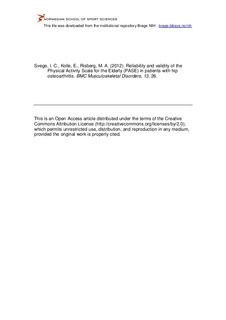| dc.contributor.author | Svege, Ida Charlott | |
| dc.contributor.author | Kolle, Elin | |
| dc.contributor.author | Risberg, May Arna | |
| dc.date.accessioned | 2012-11-15T09:30:20Z | |
| dc.date.available | 2012-11-15T09:30:20Z | |
| dc.date.issued | 2012-02-21 | |
| dc.identifier.citation | BMC Musculoskeletal Disorders. 2012, 13, 26 | no_NO |
| dc.identifier.issn | 1471-2474 | |
| dc.identifier.uri | http://hdl.handle.net/11250/171066 | |
| dc.description | © 2012 Svege et al; licensee Chemistry Central Ltd. | no_NO |
| dc.description.abstract | Background
Physical activity (PA) is beneficial in reducing pain and improving function in lower limb osteoarthritis (OA), and is recommended as a first line treatment. Self-administered questionnaires are used to assess PA, but knowledge about reliability and validity of these PA questionnaires are limited, in particular for patients with OA. The purpose of this study was to evaluate the reliability and validity of the Physical Activity Scale for the Elderly (PASE) in patients with hip OA.
Methods
Forty patients with hip OA (20 men and 20 women, mean age 61.3 ± 10 years) were included. For test-retest reliability PASE was administered twice with a mean time between tests of 9 ± 4 days. Intraclass correlation coefficient (ICC), standard error of measurement (SEM) and minimal detectable change (MDC) were calculated for the total score and for the particular items assessing different PA intensity levels. In addition a Bland-Altman analysis for the total PASE score was performed. Construct validity was evaluated by comparing the PASE results with the Actigraph GT1M accelerometer and the International Physical Activity Questionnaire (IPAQ), using the Spearman rank correlation coefficient.
Results
ICC for the total PASE score was 0.78, with relatively large error of measurement; SEM = 31 and MDC = 87. ICC for the intensity items was 0.20 for moderate PA intensity, 0.46 for light PA intensity and to 0.68 for vigorous PA intensity. The Spearman rank correlation coefficient between the Actigraph GT1M total counts per minute and the total PASE score was 0.30 (p = 0.089), and ranging from 0.20-0.38 for the different PA intensity categories. The Spearman rank correlation between IPAQ and PASE was 0.61 (p = 0.001) for the total scores.
Conclusions
In patients with hip OA the test-retest reliability of the total PASE score was moderate, with acceptable ICC, but with large measurement errors. The construct validity of the PASE was poor when compared to the Actigraph GT1M accelerometer. Test-retest reliability and construct validity revealed that the PASE was unable to assess PA intensity levels. PASE is not recommended as a valid tool to examine PA level for patients with hip OA. | no_NO |
| dc.language.iso | eng | no_NO |
| dc.publisher | BioMed Central | no_NO |
| dc.subject | adult | no_NO |
| dc.subject | aged | no_NO |
| dc.subject | exercise therapy | no_NO |
| dc.subject | methods | no_NO |
| dc.subject | gait disorders | no_NO |
| dc.subject | motor activity | no_NO |
| dc.subject | osteoarthritis | no_NO |
| dc.subject | pain measurement methods | no_NO |
| dc.subject | questionnaires | no_NO |
| dc.title | Reliability and validity of the Physical Activity Scale for the Elderly (PASE) in patients with hip osteoarthritis | no_NO |
| dc.type | Journal article | no_NO |
| dc.type | Peer reviewed | no_NO |
| dc.subject.nsi | VDP::Medical disciplines: 700::Basic medical, dental and veterinary science disciplines: 710 | no_NO |
| dc.subject.nsi | VDP::Medical disciplines: 700::Health sciences: 800 | no_NO |
| dc.source.pagenumber | 26 | no_NO |
| dc.source.volume | 13 | no_NO |
| dc.source.journal | BMC Musculoskeletal Disorders | no_NO |
